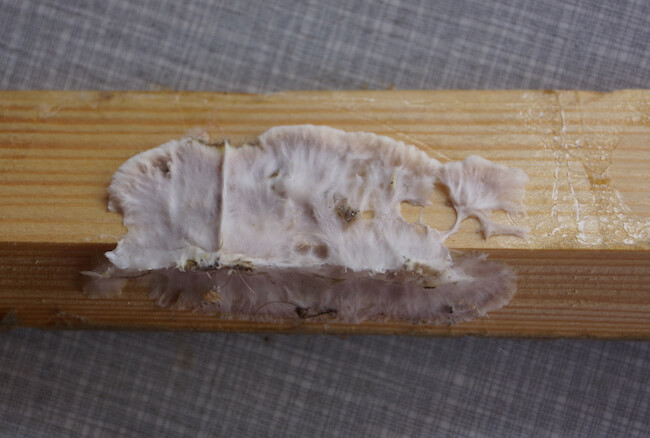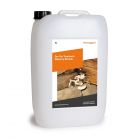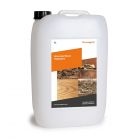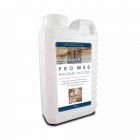Help & Advice Articles, Videos and How-to-Guides
Filter Articles
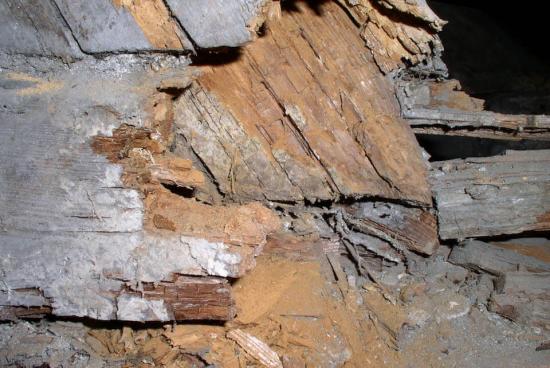
How to Identify and Treat Dry Rot & Wet Rot
Timber is used widely in houses and buildings but can be vulnerable material that needs to be protected. One of the main threats to structural timber is wet rot and dry rot.
It is important that these two types of fungal decay are distinguished because they require different treatment. In this guide, we take you through identifying wet rot and dry rot, and the types of treatment available. Both types of decay will require professional diagnosis and treatment, but we want to provide you with plenty of information so that you are well informed.
If you have already had a diagnosis, then you can jump to the relevant treatment section here:
Wet Rot
What is Wet Rot?
Wet Rot is a species of timber-eating fungus found in buildings that have unprotected timber components. There are many variations of the fungus, but the most common type is Coniophora puteana. Wet rot sustains itself by feeding on the moisture and nutrients from timber, but can also cause decay in plaster, wallpaper and carpets. Wet rot spreads by systematically feeding on wood and then emitting spores into the atmosphere in the hope of landing on a fresh wet wood surface that it can feed on.
Compared to dry rot, wet rot is less destructive as wet rot remains confined to the wet area only but still needs to be treated as it can affect a building’s structural integrity.
Types of Wet Rot
Wet Rot is a general term for several fungal species, the most common being Coniophora puteana, also known as cellar fungus. There are two common broad types of wet rot:
White rot
When wet rot fungus attacks certain species of woods, the resulting decay can take on a whiter looking appearance. This is known as white rot. White rot occurs when the fungus digests the lignin - a polymer that bonds the cells of wood together and gives it natural rigidity. White rot occurs when the fungus digests the lignin and cellulose, therefore stripping out the darker colours with it. This gives the timber a soft spongy feel when touched.
Brown rot
Brown rot takes on a darker appearance than white rot. It can look closely matched to the affected timber colour. Sometimes the wet rot fungus can’t digest the lignin in certain species of timber, so it feeds on sugars and cellulose instead. This gives the affected wood a brown appearance.
Why does wet rot occur?
Wet Rot occurs when excess moisture is present in timber over long periods of time. This type of decay affects wet timber by causing it to soften.
Wet rot is caused by moisture being absorbed into this timber. This moisture can originate from different sources.
Wet rot causes
Wet rot in timber is caused by the exposure of timber to an external or internal moisture source. Exposure of timber building elements is usually concealed and therefore undetectable. Examples of wet rot causes can include:
- Roof defects
- Plumbing leaks
- Leaky or blocked gutters
- Shower trays and around baths
- Penetrating damp through walls
- Condensation
Do I have wet rot?
Identifying wet rot is not always easy because some of the symptoms of wet rot are similar to those of dry rot. Wet rot should be identified by a professional who can tell it apart from other forms of rot by the differing colour of the decayed timber as well as the size and type of cracking it exhibits as the wet rot progresses.
The common signs of wet rot include:
- Darkened timber – darker than surrounding timber
- Soft and spongy timber
- Cracked appearance that may crumble to touch when dry
- Localised fungus growth
- Shrinkage
- A damp, musty smell
Damaged or flaky paint can sometimes be a sign of wet rot. However, with painted wood it can be harder to see evidence of wet rot. If you stick a screwdriver into the wood and it goes in easily this suggests you have an issue with rot.
Does wet rot have a smell?
Wet rot is more likely to smell than dry rot. It has a damp, musty smell that has been described as smelling earthy and like rotting soil.
Where is wet rot commonly found?
Wet rot is commonly found in cellars, roofs and in timbers around windows.
Pictures of Wet Rot
Many people want to know what wet rot looks like and how to tell it apart from dry rot. We have provided some photographs as examples of wet rot:
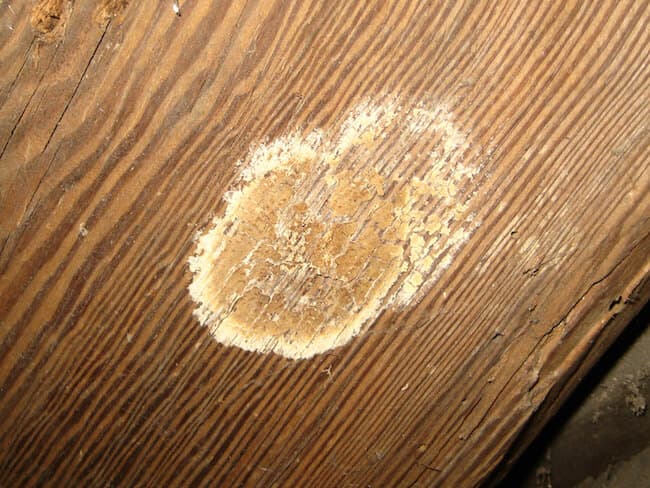
Small yellow patch of wet rot on dark wood panel By Mätes II. (Own work) [CC BY-SA 3.0] via Wikimedia Commons
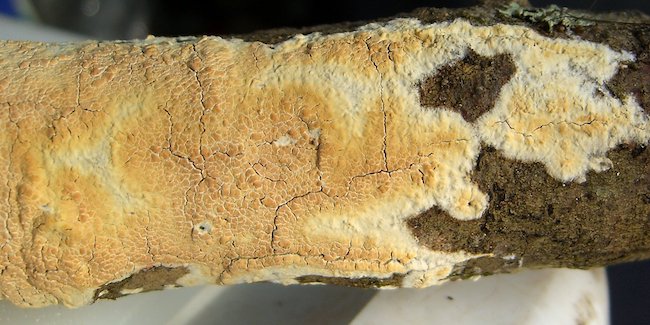
Wet rot close-up picture - By Jason Hollinger [CC BY 2.0], via Wikimedia Commons
Effects of wet rot
The danger with wet rot is that left untreated, the timber starts to lose its strength and, in some situations, may become dangerously unsafe.
Wet Rot Treatment
To solve issues with wet rot, it is important to first identify the source of moisture and stop the cause of the damp. Alternatively, you can isolate the timber from the damp source before treating the affected areas.
In some extreme cases you will need to replace the affected timbers. However, in most cases you can stop wet rot by treating the timber with a fungicide.
The treatment of wet rot involves applying a fungicide during the drying out period. The fungicide can be supplied in concentrate form (usually for professionals for use over large areas) or as a ready to use product. It can be applied using a brush or a low-pressure sprayer.
These treatments will eradicate the wet rot, as long as the source of the water ingress has been stopped.
Important note: When treating the area affected by wood rot, you should also treat the areas that are not yet affected. This will prevent future outbreaks of the decay.
Wet rot wood hardener
You can also purchase wet rot wood hardeners that soak into the timber and give it strength. These products are mainly suitable for doors and window frames.
Can I treat wet rot myself?
At Permagard, we recommend that you get a professional to identify and treat wet rot. However, our products are easy to use for those with a good basic DIY background.
Cost of wet rot treatment
The cost of wet rot treatment depends on the severity and how much timber has been affected. At Permagard we stock a range of professional and highly effective products that range from £19 (ex VAT) for 5 litres to £29.95 (ex VAT) for 1 litre of concentrate dual treatment.
If the damage is widespread and beyond repair, then you will need to replace the timbers. This can be costly.
With wet rot, you must also factor in the cost of making the repair to the source of water ingress. With roofs, this can be expensive. It always makes sense to compare quotes.
Wet Rot Products
Lignum Fungicide and Insecticide Pro – a professional treatment for wet rot, dry rot and woodworm
Universal Wood Preserver - protection against wet rot, dry rot and general wood rot
Dry Rot
What is Dry Rot?
Dry rot is the most serious form of fungal decay. It attacks the timber in buildings, digesting the parts of the timber that give it its strength.
It can spread without any source of moisture because it is able to generate moisture through the digestion of timber. Once dry rot spreads, it can severely damage the structural integrity of the building.
If you think you may have dry rot, you should arrange for a professional to carry out a survey and treat it as soon as possible. If the dry rot is not identified and treated immediately, it may be necessary to remove and replace all the affected timber.
Is dry rot a fungus?
Dry rot is a wood-destroying fungus. Its scientific name is Serpula lacrymans.
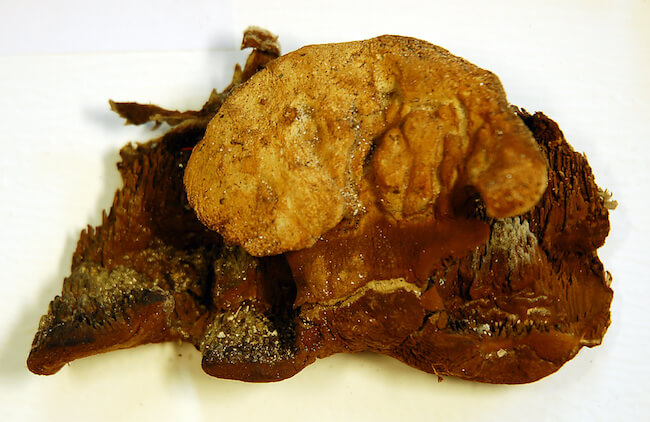
Dry rot fungus by Marcela (Own work) [GFDL 1.2 (http://www.gnu.org/licenses/old-licenses/fdl-1.2.html)], via Wikimedia Commons
Why does dry rot occur?
Dry rot spores exist in the atmosphere but only become a problem when they find themselves in the right conditions to germinate. These conditions involve damp timber with a moisture content of around 20% and that is freely accessible to air.
Causes of dry rot
The moisture in the timber that allows for dry rot to develop is usually the result of a building fault of some sort. Therefore, dry rot in homes is often caused by the following:
- leaking gutters & downpipes
- penetrating damp
- poor ventilation
- rising damp
Stages of Dry Rot
There are four main stages in the dry rot lifecycle.
- Spores – Dry rot fungus exists as spores in the air. It is present almost everywhere. The spores remain inactive until there is a source of food (timber), a certain amount of moisture (around 20%), and air.
- Hyphae – Spores that land on moist timber will start to grow as hyphae. These fine white tendrils infiltrate the timber, breaking it down. These cobweb strands act as tubes extracting and transporting moisture, like roots, from the timber.
- Mycelium – As these hyphae grow, they combine and become mycelium – a cotton wool-like substance (see below). Mycelium then starts to spread in search of new timber.
White mycelium dry rot on timber By Katarzyna Kłos (Own work) [CC BY-SA 3.0], via Wikimedia Commons
- Fruiting Body – When the fungus reaches the final stage, it fruits in a mushroom-like body. The centre of this body produces new spores (red in colour) that will become airborne and allow for the continued spread of the dry rot fungus.
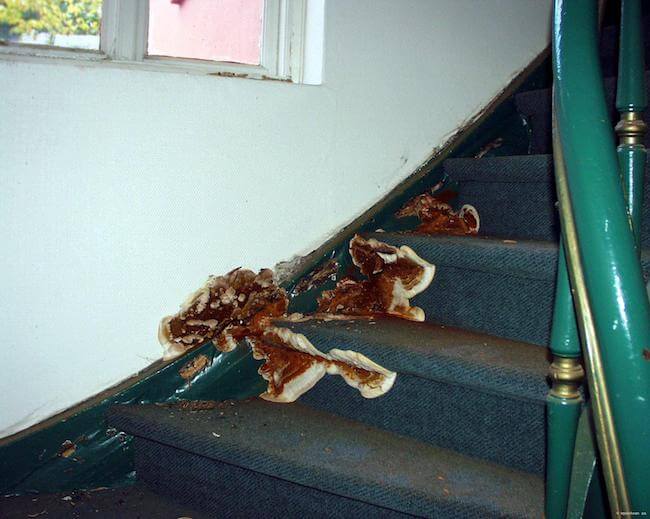
Dry rot fruiting bodies on stairs By Mycoteam AS [Copyrighted free use] via Wikimedia Commons
How does dry rot spread?
Dry rot as mycelium can travel through various materials, including brickwork and masonry. This means it can spread throughout a property. In poorly ventilated conditions, dry rot can thrive. Once the dry rot fruits, it can then pump more spores into the area.
Do I have Dry Rot?
It can be difficult to identify dry rot, especially in the early stages. The best evidence of dry rot such as mycelium and fruiting bodies occurs later in the lifecycle.
Identifying Dry Rot
The symptoms of dry rot can include the following:
- fine & fluffy white mycelium spreading across the wood. Brittle strands may develop amongst the mycelium
- grey-whitish ‘skin’ tinged with yellow and lilac patches
- mushroom-like fruiting body – soft, fleshy and looks like a pancake or a bracket – often orangey in colour, rust coloured in the centre, with wide pores
- red dust from spreading spores, often found around fruiting bodies
This video shows an inspection of a particularly extreme case of dry rot infestation:
Dry Rot in Wood
- splitting and cracking of timber into small cubes
- shrinking of the timber
- dry, brittle, crumbly timber
- darker timber
Dry Rot in Flooring
Signs of dry rot in flooring can be hard to see as it occurs under the floorboards. You may find that the floor feels bouncy, drops away from the skirting boards or floorboards may start to creak more.
Dry Rot in Masonry
Dry rot in masonry can be a serious problem. Signs of dry rot in walls are hard to see and can take several months or years before any external evidence of the fungus presents itself. If you know that timbers are affected, then you should presume that the nearby masonry / brickwork has dry rot and treat accordingly.
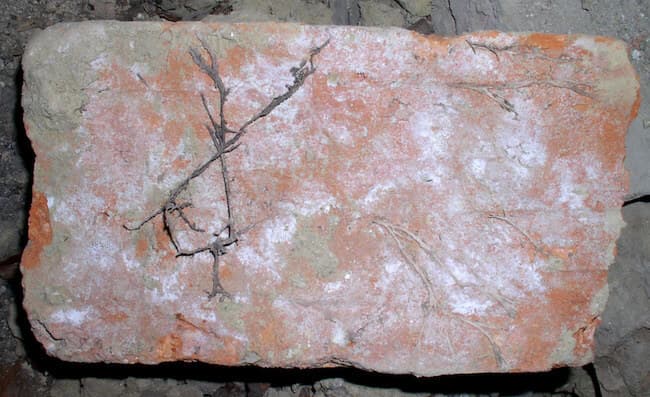
Brickwork by By Mätes II. - Own work, CC BY-SA 3.0 - via Wikimedia Commons
What does dry rot smell like?
Dry rot smell can vary according to the amount of wood affected, location and intensity of the problem. Dry rot digestive enzymes react differently to different species of wood, which means that the digestive gas they emit can vary. However, common characteristics of a typical dry rot smell include:
- Earthy odour
- Mushroom-like smell
- Musty and damp smell
What does dry rot look like?
Dry rot tends to have a white cotton wool-like appearance that coats the affected timber like a cobweb. You can also spot dry rot by the state of the timber in question which may show a distinctive type of cracking known as cuboidal cracking. This is where timber starts to crack in small square-like portions as the disease feeds on the wood’s natural moisture. As the disease spreads and progresses, you might start to notice the development of fruiting bodies among the spores. These mushroom-like spores occur when the fungus has no more fresh wood to feed on and needs to send airborne spores to colonise fresh wood.
Pictures of Dry Rot
The following are photos of dry rot:
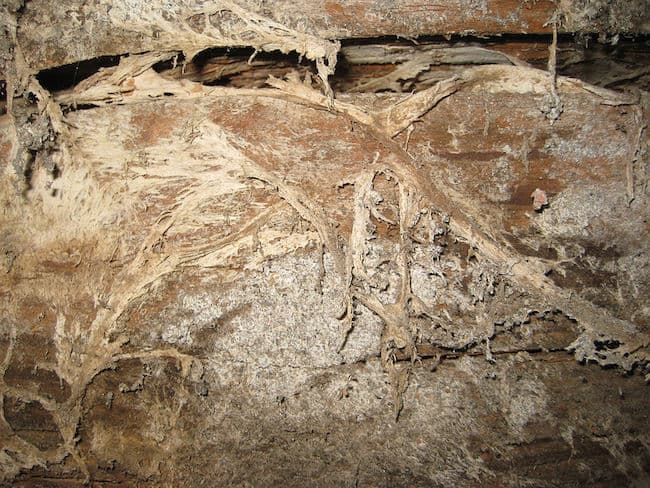
Dry rot hyphae and mycelium by Mätes II. (Own work) [CC BY-SA 3.0] via Wikimedia Commons
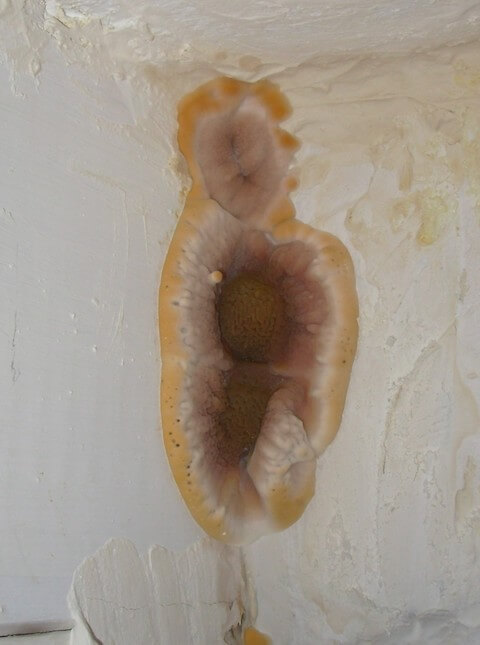
Fruiting body on wall By Verber31 (Own work) [GFDL (http://www.gnu.org/copyleft/fdl.html) or CC BY 3.0], via Wikimedia Commons
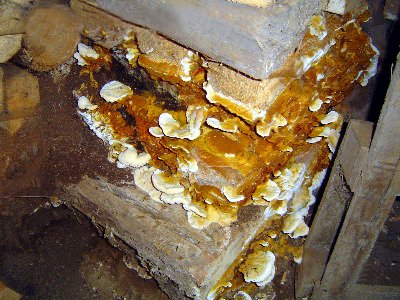
Dry rot in corner of basement by Sachverständigenbüro für Zimmerei und Holzbau Lutz Weidner [GFDL or CC-BY-SA-3.0] via Wikimedia Commons
Effects of Dry rot
There are several problems with dry rot, particularly the damage to the structural integrity of a building. This can come with a huge financial cost, but also be a safety concern for those inside. A house with dry rot is not a pleasant place to be and developed forms of dry rot can permeate the air with a damp soil-like smell. As the most serious form of fungal decay, it can also make it difficult to sell a house.
Dry Rot Health Risks
Dry rot spores in themselves are not harmful to your health. However, the damp conditions the fungus needs to germinate can represent a health hazard for older people, infants and those with respiratory conditions.
Dry Rot Treatment
The first stage of treatment of dry rot is to find the source of the moisture and fix the fault.
You will then need to determine the full extent of the dry rot outbreak. To do this, you should open up the affected area by removing plaster and render in all directions as well as removing flooring and lifting floorboards. You should now be able to identify the infected timbers.
Dry rot treatment for wood & timber
Once you have identified the infected timbers, it is recommended that you cutback the timbers in-situ to at least 500mm beyond the last signs of fungal growth or hyphae strands.
You will then need to remove all fruiting bodies and visible spores. Clean all wall areas to remove surface growth including hyphae, mycelium and fruiting bodies. A stiff brush can be used on the walls if required.
You should replace the timber with pre-treated timber. All remaining sound timber new and old should then be liberally treated with a dual-purpose dry rot treatment fluid. These specially formulated fungicides will kill dry rot and stop re-infestations, preventing any further outbreaks of the fungus.
You will also need to sterilise the masonry.
Masonry Dry Rot Treatment
Masonry surfaces will need to be sterilised with a masonry dry rot treatment. Dry rot treatments for masonry and brickwork involve applying a high strength fungicidal microemulsion either by spray or injection.
Designed to penetrate deep into the substrate, the biocide targets the fungus and stops it from spreading. It delivers long lasting control of dry rot and fungal growth in the masonry. It can also be used as a subfloor steriliser where necessary in areas of dry rot outbreaks.
Buy Masonry Dry Rot Treatment - 1 Litre Concentrate now or check out our masonry biocide bulk deal.
Dry Rot Treatment Costs
The cost of dry rot treatment is relatively small. At Permagard, we stock a ready-to-use dry rot solution priced at £13.50 (ex VAT) for five litres, as well as a concentrated masonry treatment at £18.50 per litre (ex VAT). If you're treating a larger area, quantities can add up - which is why we offer our dual-purpose fungicide and insecticide as a cost-effective bulk option.
There are several other costs associated with dry rot treatment.
- Dry rot survey - You will want to have a professional confirm the presence of dry rot. A dry rot survey can cost between £200 and £400.
- Dry rot repairs - The cost of dry rot repair will depend on the amount of timber affected. If you need to replace a large amount of timber, this will be expensive.
Permagard - Providing Solutions. Inspiring Confidence.
Permagard’s wet and dry rot treatments are highly effective at dealing with these types of rot. We are happy to provide technical advice on our range of timber treatments and help ensure your issue is resolved - just give us a call on 0117 982 3282.
Main header image shows timber damaged by dry rot by Mätes II. (Own work) [CC BY-SA 3.0], via Wikimedia Commons. This article and the images / videos used within are designed for educational purposes. If anyone has concerns over copyright or our use of their images, please contact us.
